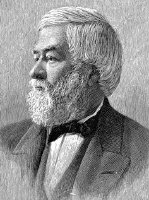Miscellaneous

“The Grier’s Creek Mill Cluster in Woodford County, Kentucky, with Some Observations on the Nature of So-Called ‘Flint’ Millstones.” The Millstone 16 (Spring, 2017), 3-22. Kentucky Old Mill Association. Although a rural area, the corridor of Grier’s Creek in Woodford County, Kentucky, became an industrial cluster beginning early in the nineteenth century as numerous water-powered grist mills and later, whiskey distilleries, were erected. This article discusses the various establishments, and also includes a discussion of the Tanner millstone quarry. This quarry, previously unknown, was shown to Gary O’Dell and Jim Currens by a local resident, and is significant as the only known chert millstone quarry operating in the latter 1700s. The quarry contains numerous partly shaped or broken millstones, manufactured from a thin bed of cherty limestone located on a hillside bench about 100 feet above the creek.
“Cassius Marcellus Clay.” In Clark’s Kentucky Almanac 2007 (Lexington, KY: Clark Group, 2007), 53-54. This is a brief biography of Cassius Marcellus Clay of Kentucky (1810-1903), a cousin of statesman Henry Clay, who lived in Madison County on the large estate known as White Hall (today a state park). Clay was a radical politician and an ardent abolitionist who published an anti-slavery newspaper in Lexington, the True American, which often led to violent conflicts with fellow citizens.
Eco-Efficiency and Lean Production: Environmental Performance of Japanes Transplants in the United States. Ph.D. diss., University of Kentucky, 2003. Prior to 2000, Japanese direct investment in U.S. manufacturing was one of the most significant components of total foreign investment. A greater impact may have been achieved by the diffusion and hybridization of Japanese management methods, commonly known as “lean production.” Attributes of these systems such as a focus upon efficiency and continuous improvement provided a competitive advantage that allowed Japanese corporations to penetrate and capture technology markets formerly dominated by Western industry. A number of writers, supported by empirical research, have also observed that these same characteristics provide a potential for environmental benefits in terms of resource productivity and pollution prevention. These concerns are central to an emerging perspective, known as ecological modernization, that represents an evolutionary change in industry’s and government’s approach to environmental issues from reactive to proactive.
This study is grounded within the theoretical framework of ecological modernization, and explores the role of three key features of this movement, eco-efficiency, industrial ecology, and environmental management systems, as part of a strategy to compare the environmental performance of Japanese transplants to non-Japanese facilities in the United States. The study area consists of the four states, Indiana, Ohio, Kentucky and Tennessee, which represent a dense concentration of Japanese manufacturing investment. The study employs both quantitative and qualitative methodologies, and has three primary objectives: (1) to construct an eco-efficiency indicator that uses readily available data and is applicable to a broad range of firms; (2) to compare the performance of Japanese and non-Japanese firms using the eco-efficiency and other appropriate indicators, and through survey techniques and case studies to develop an understanding of environmental policies and practices at the firm level; and (3) to provide a comprehensive account of the geographical distribution and characteristics of Japanese investment in the region.
“Assessing Environmental Performance of Japanese Industrial Facilities in Kentucky.” In Japan in Kentucky, P.P. Karan, ed. (Lexington: Univ. Press of Kentucky, 2001), 222-259. Beginning with the establishment of the Toyota automobile assembly plant in Georgetown in 1988, by the beginning of the 21st century Japanese-based manufacturing firms had invested more than $7 billion erecting more than a hundred factories in the state. Including case studies of specific plants, this article analyzes federal RCRA and TRI hazardous waste data to assess the environmental performance of such companies. The results indicate that Japanese firms, whose production methods emphasize efficiency, tend to be environmentally proactive in dealing with hazardous waste.
“The Changing Fortunes of a Small Town in Kentucky.” Focus 45 (Winter, 1999): 9-19 American Geographical Society. With Duane D. Allen. The small town of Livingston, Kentucky, is located in eastern Rockcastle County. This article examines how changes in regional transportation infrastructure since the Civil War, railroad and highway, affected the growth and development of the community, and the heated controversy over the closing of the Livingston Elementary School/
O’Dell, G.A. (1978) “Media Particle-Size Effects on Rooting” (with L.P. Stoltz). Plant Propagator 24:4-8. In 1977, this paper received the first-place award in the Biological Sciences category of the University of Kentucky’s Oswald Undergraduate Research competition, and also the Undergraduate Research Award from the International Plant Propagator’s Society. The paper reports the results of an experiment to determine the effects of five particle size grades of sand, ranging from 0.05-0.10 mm to >1.0 mm and unsieved builders sand, on the rooting of cuttings of three different plant species. A discussion of the results includes the influences of water content, free porosity, and aeration on root initiation and growth.







